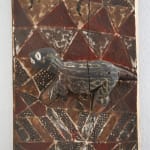 Nkanu wall panel
Nkanu wall panel
 Nkanu wall panel
Nkanu wall panel
Anonymous Nkanu artist (D.R. Congo)
21 13/20 x 12 99/100 in
The Nkanu inhabit the eastern part of the Lower Congo province of the Democratic Republic of the Congo and northern Angola. As among many cultures throughout the world, the passage from childhood to young adulthood was celebrated as a significant event in one’s life. Among the Nkanu, nkanda was the initiation society used to transition male children into manhood. Nkanu boys were taken to a bush camp (kimpasi) outside of the main village, circumcised and taught what it took to become a man, including hunting and sexual practices. Just before the final reintegration of the circumcised initiates, ritual specialists and sculptors build a kikaku - a three-sided roofed hut with an open front placed at a crossroads outside the initiation enclosure - within which sculpted polychrome panels adorned the interior walls. The carved images on the panels were said to depict metaphoric images of rebirth, sexual maturity, fertility, death and the spirit world, as well as community values - metaphors that only initiated men understood. The aim of displaying the panels was to remind initiates about the lessons learned during the initiation period.
This beautiful wall panel shows a leopard in high relief at the center, with the background decorated with geometric shapes. Although the polychrome surface decoration added to the visual impact of the panel, the use of color and decorative patterns primarily served to carry a message. To those who could read their iconography, these designs were the equivalent of written documents. Diagonal lines in a square, for example, were connected with the masamba fibers that the initiates wore crossed of their chest; they were symbolic of fertility and the sexual maturity of the wearer, and had protective powers. Triangles with the top pointed up also symbolized the male sex organ; if reversed, it stood for the female sex. Among the Nkanu, the leopard was associated with traditional leadership. Indeed, animals represented on these panels often represented the chief (mfumu mpu) and his supreme power over life and death. Like many predators, the chief always captured the transgressors of ancestral laws.
A panel featuring a Kakungu face mask of a identical size and in all likelihood once belonging to the same kikaku was sold by the auction house Lempertz on 24 April 2010 (lot 82). Two other Nkanu panels with similar dimensions and decorations, but featuring different animals, are in the collection of the Peggy Guggenheim foundation in Venice (76.2553 PG 252-253).
Provenance
Private Collection, UK, 2015Private Collection, Belgium, 2015-2024
Duende Art Projects, Antwerp, Belgium, 2024
let's keep in touch
Join our community & never miss out on a DUENDE moment from now on
* denotes required fields
We will process the personal data you have supplied to communicate with you in accordance with our Privacy Policy. You can unsubscribe or change your preferences at any time by clicking the link in our emails.

